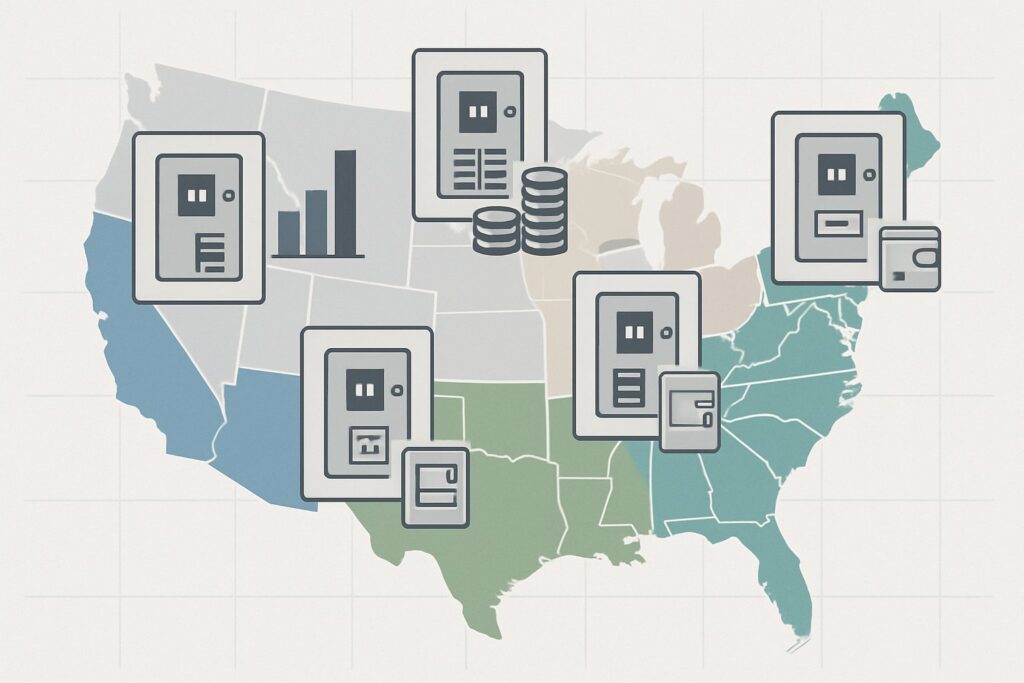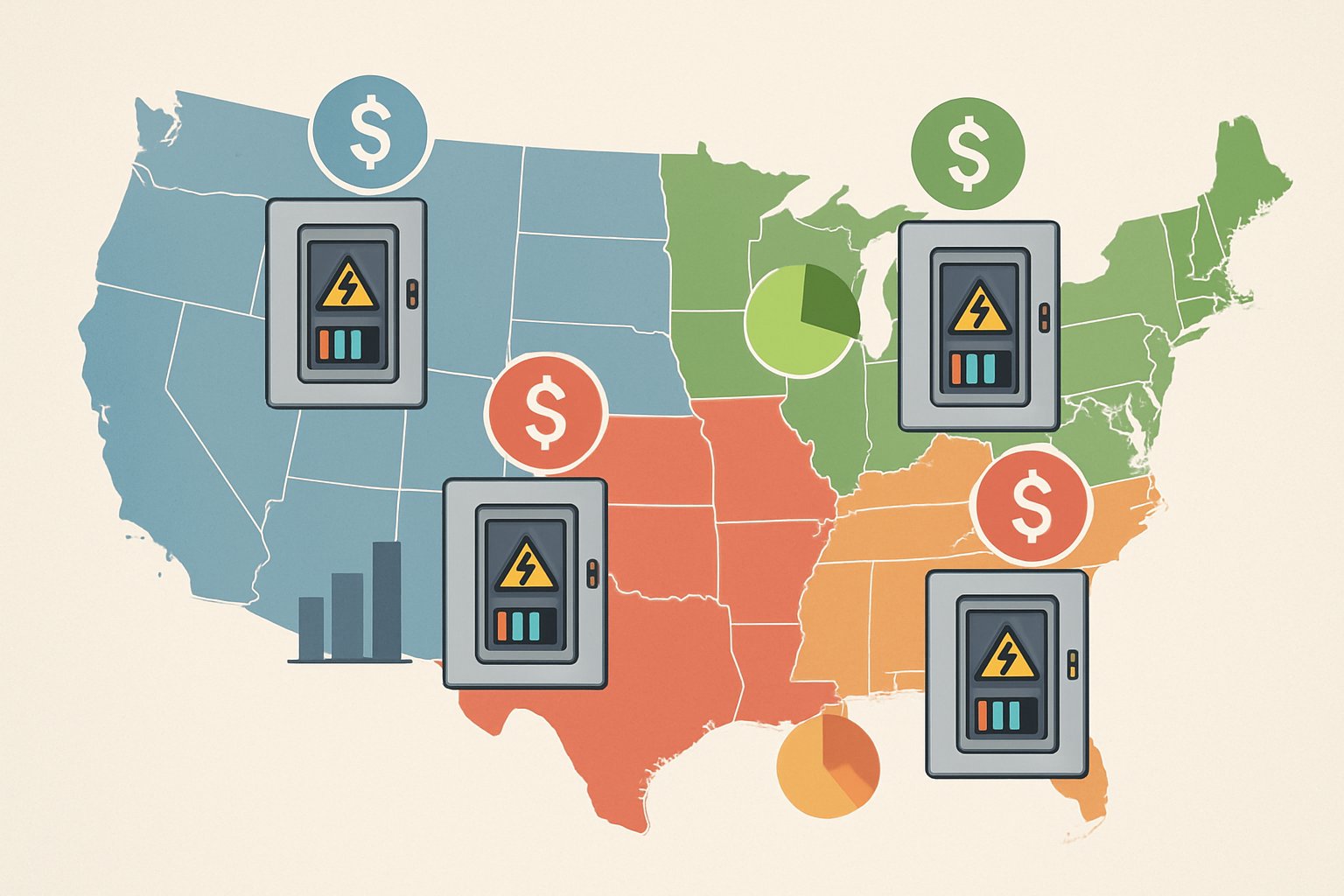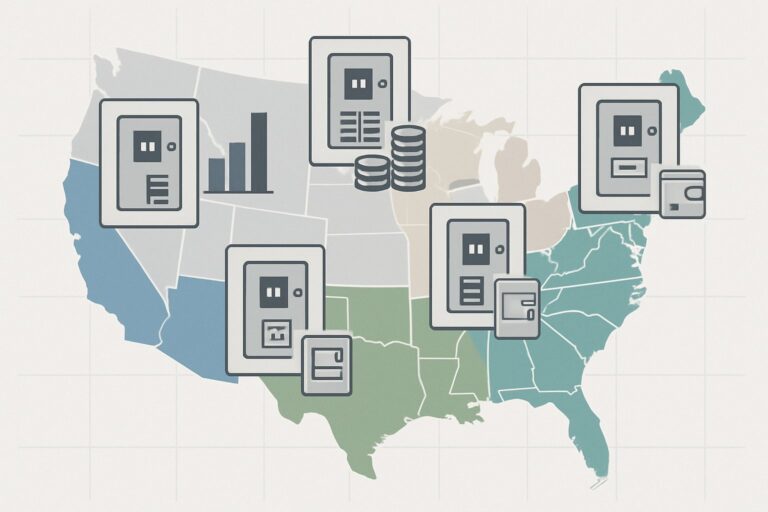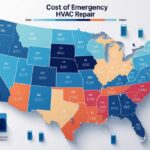Upgrading your electrical panel might run you anywhere from $800 to $4,000. The final price really depends on where you live.
Regional differences in labor costs, permit fees, and local building codes can push electrical panel upgrade expenses thousands higher or lower depending on your area.

In big cities like New York or San Francisco, labor rates often hit $80 to $120 per hour. Meanwhile, rural electricians might charge just $40 to $70 for the same job.
Permit costs usually fall between $50 and $500 depending on local rules. Some towns tack on extra inspections that can bump up your total bill.
Need a Home Fix – Emergency or Routine?
From leaks and no-heat nights to simple tune-ups, our 24/7 hotline connects you with trusted local pros in minutes.
Local building codes and utility company rules also play a part. If you can’t find a licensed electrician nearby, you might pay more just for availability.
Key Takeaways
- Electrical panel upgrades cost $800 to $4,000, and prices swing a lot based on local labor and permit fees
- Labor rates can differ by $40 an hour between cities and small towns, making a big impact on your project cost
- Smart panel choices and picking the right contractor affect both your upfront cost and your home’s value in the long run
What Is an Electrical Panel Upgrade?
When you upgrade your electrical panel, you swap out your old breaker box for a newer, higher-capacity one. This isn’t just about safety—it’s about letting your home handle today’s bigger power needs.
Purpose of an Electrical Panel
The panel is your home’s electrical headquarters. It takes electricity from the utility company and sends it out to all the circuits in your house.
Homes today demand way more power than they did decades ago. Think about all the devices and appliances we use now—old panels just can’t keep up.
An electrical panel upgrade boosts safety and helps prevent fires. Newer panels come with features like ground fault circuit interrupters and arc fault protection.
Key functions include:
- Distributing power to each circuit
- Protecting your home from electrical overloads
- Cutting off power during emergencies
- Supporting modern appliances and tech
If you want to add things like an EV charger, hot tub, or a whole-house generator, you’ll need a panel that can handle the extra load. Older panels just aren’t built for that.
Common Signs You Need an Upgrade
There are a few warning signs that scream it’s time for a new breaker panel. Flickering lights often mean your system’s overloaded and struggling to keep up.
If you ever smell something burning near your panel, that’s a red flag—overheating parts can cause fires.
Critical warning signs include:
- Frequent breaker trips – Circuits shut off even when you’re not doing anything unusual
- Rust or corrosion – Water damage is a serious safety issue
- Outdated panel brands – Federal Pacific and Zinsco panels are notorious fire risks
- Age over 25 years – Most panels top out at 25-40 years
Insurance companies sometimes force upgrades for certain panel types. Some old brands just can’t get you coverage because of known problems.
Adding big appliances—like a new AC or electric stove—can push an old system past its limits. That’s when upgrades become non-negotiable.
Differences Between Breaker Panels and Fuse Boxes
Modern breaker panels use circuit breakers you can reset. Fuse boxes use fuses you have to replace every time they blow.
Circuit breaker boxes are safer and way more convenient. If a circuit overloads, you just flip a switch to reset it.
Fuse box downsides:
- Fuses need replacing after every overload
- No ground fault protection
- Limited capacity
- Fire risk if you put in the wrong fuse
Most fuse boxes only offer 60-100 amps. That’s not enough for a modern home—most need at least 200 amps for everything to run smoothly.
Switching from a fuse box to a breaker panel usually costs $1,630 to $4,070. It’s a solid investment for safety, capacity, and code compliance.
Breaker panels also bring modern safety features. Ground fault and arc fault protection cut down on shocks and fire risks—huge improvements over old fuse setups.
National Electrical Panel Upgrade Costs Overview

Electrical panel upgrades run from $800 to $4,070 nationwide. Most folks end up paying around $2,730.
Your final price depends on how much amperage you need, local labor rates, and whether you need a full replacement or just a simple upgrade.
Average Costs by Amperage (100-400 Amps)
The amperage rating tells you how much current your panel can handle. Higher amperage means higher cost, but also more capacity for all your gadgets and appliances.
100 Amp Panels cost between $800 and $1,600 with labor and materials. They’re fine for smaller homes with basic needs, but don’t expect to run a bunch of big appliances at once.
200 Amp Panels are the sweet spot for most modern homes. They’ll set you back $1,300 to $3,000 and can handle central AC, electric water heaters, and several appliances running together.
400 Amp Panels cost $2,000 to $4,000. If you have a big house, an EV charger, or a workshop, you’ll probably need this much juice.
| Amperage | Cost Range | Best For |
|---|---|---|
| 100 Amp | $800 – $1,600 | Small homes, basic needs |
| 200 Amp | $1,300 – $3,000 | Standard modern homes |
| 400 Amp | $2,000 – $4,000 | Large homes, high demand |
Cost to Replace vs. Upgrade an Electrical Panel
Replacing means pulling out the whole panel and putting in a new one. Upgrading just means boosting your current panel or adding capacity—no full swap needed.
Panel Replacement costs more because the electrician has to disconnect everything and haul out the old gear. Full replacement usually runs $1,630 to $4,070. If you have a fuse box or a really old panel, you’ll probably need a full replacement.
Panel Upgrades are cheaper if your current setup can handle improvements. Adding circuits or bumping up amperage without a full replacement saves cash, but older homes often need more than just a quick upgrade.
The cost to replace a panel covers removing old wiring, putting in new breakers, and updating connections. Upgrades might just mean swapping breakers or adding circuits.
Electrical Panel Cost Breakdown
Knowing what you’re actually paying for helps a lot with budgeting.
Labor Costs usually eat up 50-70% of your total. Electricians charge $40-$120 per hour, and panel work can take 8-10 hours. Only licensed pros should handle this stuff—it’s not a DIY job.
Materials and Equipment include the panel ($200-$800), breakers ($5-$50 each), and wiring. Copper wire runs $1-$4 per foot. Surge protectors, if you want them, add $200-$500.
Permits and Inspections cost $50-$500, depending on your area. Every panel job needs permits and inspections to make sure it meets code and is safe.
Additional Work can make the price jump. Rewiring an old house might add $1,000-$4,000. If you need to move the panel, that’s another $500-$2,000. Panel costs go up fast with extras like these.
Regional Variations in Electrical Panel Upgrade Costs
Panel upgrade costs change a lot from one region to the next. Local labor, permits, and cost of living can make the same job run $1,000 or $4,000, depending on your zip code.
Cost Differences by State and City
The cost to replace a panel swings wildly between states and cities. High-cost places like California, New York, and Massachusetts often charge 40-60% above the national average.
High-Cost Regions:
- San Francisco Bay Area: $2,500-$5,000
- New York City: $2,200-$4,500
- Boston: $2,000-$4,200
- Seattle: $1,900-$4,000
Moderate-Cost Regions:
- Chicago: $1,500-$3,200
- Atlanta: $1,400-$3,000
- Denver: $1,300-$2,800
Lower-Cost Regions:
- Dallas: $1,200-$2,600
- Phoenix: $1,100-$2,500
- Cleveland: $1,000-$2,400
Big cities almost always cost more than nearby suburbs. That same 200-amp upgrade might be $3,500 in downtown San Francisco but only $2,200 just outside the city.
Factors Influencing Regional Pricing
Local labor rates drive most regional price differences for electrical work. Electricians in pricey areas might charge $80-$150 per hour, while those in cheaper regions often ask for $40-$80.
Permit fees vary widely:
- California: $200-$800
- Texas: $75-$300
- Florida: $100-$400
- New York: $150-$600
Local building codes can bump up your costs, too. Some places want extra safety features like whole-house surge protection or special grounding systems.
Material prices jump around based on what suppliers are nearby. Folks in remote spots sometimes pay 15-25% more for electrical parts thanks to shipping costs.
If your area has several electrical supply companies, you’ll usually see better prices. Competition’s a good thing, right?
State licensing requirements influence pricing:
- Stricter licensing usually means higher rates
- Places that require continuing education tend to charge more
- Regions needing master electricians tack on extra costs
Urban vs. Rural Upgrade Costs
Urban upgrades usually run 20-40% higher than rural jobs for the same electrical panel upgrade cost. Big cities come with higher overhead, tougher permits, and pricier labor.
Urban advantages include:
- More contractors to pick from
- Permits get processed faster
- Materials are easier to find
- Specialized electricians are around
Rural challenges:
- Fewer contractors available
- Electricians have to travel farther
- Not many material suppliers nearby
- Sometimes you’ll need a utility service upgrade
Rural properties sometimes need upgrades to the electrical service line from the street. Working with the utility company on this can tack on $500-$2,000.
Small towns might have only a handful of licensed electricians. Less competition can mean higher prices, even if overhead is lower. Sometimes electricians drive 50+ miles just to get to the job, so travel charges show up on the bill.
Cost comparison for 200-amp upgrade:
- Major cities: $2,000-$4,500
- Suburbs: $1,500-$3,500
- Small towns: $1,200-$3,000
- Rural areas: $1,000-$2,800
Factors That Affect Electrical Panel Upgrade Costs
Amperage capacity and circuit needs make the biggest difference in upgrade costs. Smart panels cost more upfront than standard panels, and if your system’s old, rewiring can get pricey fast.
Amperage and Number of Circuits
The panel’s amperage rating tells you how much power it can handle. Higher amperage panels cost more—both for the gear and the install.
A 100-amp panel usually runs $800 to $1,600 installed. Works fine for smaller homes with basic needs, covering about 20 to 24 circuits.
200-amp panels go for $1,300 to $3,000 installed. Most newer homes need this for things like AC, electric appliances, and lots of devices. These handle 40 to 42 circuits.
400-amp service jumps to $2,000 to $4,000 or more. You’ll need this if you’ve got an EV charger, a workshop, or a seriously wired smart home.
More circuits mean higher material costs. Each breaker can cost $5 to $50, depending on what you need. Standard breakers are cheaper than GFCI or AFCI types.
Labor goes up as you add circuits. Electricians spend extra time hooking up each one and making sure everything’s safe.
Type of Electrical Panel (Standard vs. Smart)
Standard breaker panels cost way less than smart ones. The old-school panels just use basic breakers—no fancy monitoring.
Standard panels come with a main breaker and individual circuit breakers. You’ll pay $200 to $800 for the panel itself. They’re reliable, just not loaded with extras.
Smart panels cost $1,000 to $4,000 for the equipment. These let you monitor circuits, control them remotely, and track energy use on your phone.
Some smart panels can shut off certain circuits automatically during peak hours. That’s handy if you’re trying to shave your electric bill in areas with time-of-use rates.
Install costs don’t change much between panel types. The price difference is all about the equipment and maybe some extra setup for the smart features.
If you want the smart stuff, you might need extra wiring for communication systems. That can add another $200 to $500, depending on your home’s layout.
Existing Electrical System Condition
Older electrical systems can throw a wrench in your budget. Homes from before the 1970s might need a lot of rewiring.
Aluminum wiring from the ‘60s and ‘70s needs special attention or outright replacement. That could add $1,000 to $4,000 to the job.
Knob-and-tube wiring in really old homes has to go. Swapping it out can cost $3,000 to $8,000.
Grounding upgrades usually run $200 to $800 more. Lots of older homes just don’t have proper grounding, and codes demand it now.
If you have to move the panel to meet code, expect another $500 to $2,000. Panels can’t be in bathrooms, closets, or other off-limits spots.
Sometimes you’ll need a service line upgrade from the utility company. That’s $300 to $1,500, depending on what your local utility wants and how far your house is from the street.
Hiring a Licensed Electrician for Your Upgrade
Electrical work isn’t something to mess around with. Licensed electricians have the training to keep your home safe and up to code, and you really want that peace of mind.
Why Use Licensed Electricians
Licensed electricians go through a ton of training and testing. They know their way around complicated wiring and spot hazards that most of us would totally miss.
Upgrading a panel is a job for a licensed pro—bad installs are a huge fire risk. DIY work can break building codes and even mess with your insurance coverage.
Pros carry liability insurance, so if something goes wrong, you’re protected. They also usually back up their work with warranties, which is a relief if something fails later.
Key benefits of hiring licensed electricians:
- Safety expertise – They know how to handle high-voltage systems safely
- Code knowledge – They’re up on the National Electrical Code
- Insurance protection – You’re covered for accidents and property damage
- Quality assurance – Warranties and real accountability
Permits, Codes, and Inspections
Getting the right permits and inspections isn’t optional for panel upgrades. Licensed electricians handle the paperwork and make sure everything meets the National Electrical Code.
Permits usually cost $50 to $200, depending on your local rules. That covers the plan review and inspections to make sure the work’s safe.
The National Electrical Code lays out safety standards that electricians have to follow. Code compliance helps prevent fires and keeps your system running right.
Typical permit and inspection process:
- Permit application – Filed before any work starts
- Initial inspection – Checking materials and setup
- Final inspection – Testing everything after install
- Code compliance – Making sure it passes the National Electrical Code
Labor Costs and Estimates
Licensed electricians usually charge $50 to $100 per hour, and panel upgrades take 8 to 10 hours. Labor is often the biggest chunk of the total cost.
A licensed electrician will check your current panel and wiring before quoting you a price. That way, you get an accurate estimate and a solid plan.
Ask for detailed quotes from a few electricians so you can compare costs and services. Getting more than one estimate is just smart.
Your location has a big effect on labor rates. High cost-of-living areas mean higher electrician rates, which pushes up your total bill.
Factors affecting labor costs:
- Project complexity – Extra wiring or changes cost more
- Regional rates – Local demand and market rates
- Experience level – Master electricians charge more than journeymen
- Timeline requirements – Need it done fast? Expect to pay extra
Tools and Resources for Estimating Costs
There are a bunch of cost calculators and estimation tools out there to help you figure out your upgrade budget. Still, licensed electricians give the most accurate pricing for your specific project.
Using an Electrical Panel Upgrade Cost Calculator
An online calculator factors in your home size, current wiring, and a few other basics to spit out a ballpark estimate. Handy for getting a sense of what you’re in for before calling anyone.
Most calculators ask for things like:
- Square footage of your home
- Current panel amperage (100, 150, 200 amp, etc.)
- What you want to upgrade to
- Your location
- Type of wiring you have
The Kukun calculator even adjusts for local labor and material costs, so it’s a bit more realistic than most generic tools out there.
Panel upgrade estimators are great for DIYers who want to get a rough idea. Just remember, they can’t account for weird installation quirks or surprises behind your walls.
Getting Accurate Quotes and Estimates
Professional quotes from licensed electricians give you the most reliable cost estimates. Contractors notice specific site conditions that online calculators just can’t catch.
When electricians visit for an estimate, they look at a bunch of factors:
- Existing panel condition and accessibility
- Required permit costs ($50 to $350)
- Electrical line capacity from utility company
- Additional wiring or circuit needs
- Code compliance requirements
Ask for quotes from at least three licensed contractors. Look closely at their statements of work so you’re comparing apples to apples.
Check each contractor’s license, insurance, and references before you decide. Most professional estimates cover labor, materials, permits, and inspection costs in the total price.
Upgrading to Smart Electrical Panels and Future Considerations
Smart electrical panels are sort of a leap ahead, offering monitoring and control features that old-school panels just don’t have. The price difference between standard and smart setups can swing a lot depending on where you live and what features you want.
Benefits of Smart Electrical Panels
Smart electrical panels provide real-time energy monitoring so you can track your electricity use circuit by circuit. It’s honestly eye-opening to see which appliances are gobbling up power all day.
Remote Control Capabilities
You can control your electrical system from anywhere with a smartphone app. Turn circuits on or off, watch your usage, and get instant alerts if something’s up.
Enhanced Safety Features
Smart panels spot electrical problems before they get dangerous. They’ll ping you if there’s an overloaded circuit, a ground fault, or something else sketchy that could cause a fire.
Energy Management
These panels help optimize your energy use by adjusting power distribution automatically. They’ll put essentials first during peak hours and dial back on non-essential stuff.
Future-Ready Technology
Smart panels set you up for electric vehicle charging and solar panel integration. They manage the extra load from these technologies, so you won’t need another upgrade down the road.
Cost Comparison: Traditional vs. Smart Panels
Traditional electrical panel upgrades usually run between $1,200 and $3,000 for a basic install. Smart panel upgrades? Expect $2,500 to $6,000, depending on what you want and where you live.
Traditional Panel Costs
- Basic 200-amp panel: $1,200 – $2,500
- Installation labor: $500 – $1,000
- Permits and inspections: $100 – $300
Smart Panel Investment
- Smart panel hardware: $1,500 – $3,500
- Professional installation: $800 – $1,500
- Setup and configuration: $200 – $500
Long-term Value
Smart panels can shave 10-15% off your energy bills with better monitoring. Most folks save around $150-300 per year after installing one.
Regional Price Variations
If you’re in a big city like New York or San Francisco, install costs can run 20-30% higher. Rural areas usually have fewer smart panel options, but labor is cheaper.
Frequently Asked Questions
Electrical panel upgrades for 200 amp systems usually cost between $1,630 and $4,070. Where you live makes a big difference—labor, permit fees, and materials all vary a lot between cities and rural areas.
How much does it generally cost to upgrade to a 200 amp electrical panel?
A 200 amp electrical panel upgrade costs about $2,730 nationally, but you might pay anywhere from $1,630 to $4,070. Complexity and local labor rates play a big part in the final bill.
For most homes, 200 amps is plenty for modern appliances, AC, and electronics. It’s enough juice for the typical household without overloading things.
If your home needs new wiring or a service upgrade, expect the price to climb. Those changes can add thousands to your total project cost.
What are the cost implications of upgrading an electrical panel to 300 amps?
Upgrading to a 300 amp electrical panel averages $4,095 nationally. Depending on your area and needs, you could pay anywhere from $2,445 to $6,205.
Homes with lots of high-powered appliances, electric heat, or big workshops usually need 300 amps. If you’ve got multiple AC units or a serious shop setup, it’s probably worth it.
The higher cost comes from bigger conductors, beefier equipment, and sometimes utility upgrades. Labor goes up too, since handling all that heavy gear takes more time.
Is there a difference in electrical panel upgrade costs between regions?
Yeah, regional differences are real. Labor rates, permit fees, and local codes all affect what you’ll pay. States with higher living costs almost always charge more for electrical work and materials.
Permits can be anywhere from $50 to $200, depending on where you live. Some places want extra inspections or special equipment, which bumps up the price.
Local codes might require certain panel types or installation methods. That can change both your materials and the time it takes to get the job done.
What factors influence the cost to replace an electrical panel and associated wiring?
Panel size is the main thing—100 amp upgrades average $1,365, but bigger systems cost a lot more. The condition and complexity of your existing wiring matters too.
If your house needs a lot of rewiring, costs go up fast. Older homes with outdated wiring often need a total overhaul, not just a new panel.
Distance from the meter to the panel also affects price. Moving a panel a short distance costs $800 to $1,200, but a long move can hit $4,000.
Permit requirements, local code rules, and how easy it is to reach the panel all play a part. Tight spaces or tricky installs mean more labor and a higher bill.
Can an electrical panel upgrade cost be accurately estimated with an online calculator?
Online calculators are okay for a ballpark figure, using basic info like panel size and location. They use average costs but can’t see your home’s quirks or hidden problems.
Real costs often end up different from those estimates, especially if something unexpected comes up. Old wiring, code issues, or structural surprises can all make the job bigger.
In-person evaluations by a pro electrician give you a much better idea of the real cost. They can spot potential headaches on-site and factor them into the estimate.
How does the cost of upgrading an electrical panel compare in urban versus rural areas?
Urban areas usually come with higher labor costs. That’s mostly because overhead is steeper and wages just tend to run higher in cities.
On top of that, cities often pile on stricter permit requirements. The inspection process can get pretty tangled, too.
In rural areas, material costs sometimes spike. Blame transportation fees or just not having many suppliers nearby.
But lower labor rates can balance things out. Sometimes, those savings make a real difference.
Finding a qualified electrician isn’t always easy, especially out in the country. With fewer contractors, prices might climb—less competition and longer drives for service calls will do that.







Leave a Reply